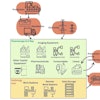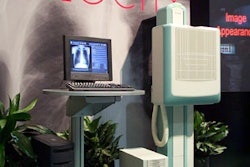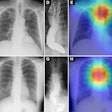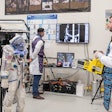Hoping to bridge the performance gap between single and multibay computed radiography readers, Konica Medical Imaging debuted its dual-bay Xpress CR system at the 2002 RSNA meeting in Chicago last month.
Equipped with both input and output bays, Xpress CR allows users to insert two cassettes in six seconds, up to a total of four before one needs to be removed, according to the Wayne, NJ-based vendor. Konica points to the speed of Xpress CR as a key benefit.
Users can receive fully processed images within 24 seconds, with a total cycle time of 40 seconds for a 14 x 14-inch plate at standard resolution. The reader streams the image data to the control station as it scans the plate, reducing wait times for the technologist, said Randy Mattingly, business unit manager at the company.
Up to 90 plates can be processed per hour, according to the vendor. Two Xpress CR readers set up side-by-side can produce a four-view study in less than two minutes. This configuration offers significant advantages, according to Mattingly.
"With its throughput and redundancy capabilities, Xpress CR can compete in both the single-bay and multibay (CR markets)," he said.
Per reader, Xpress CR can handle up to approximately 20,000 imaging procedures per year, with combined configurations able to accommodate enterprise-wide imaging requirements. The system can support cassette sizes of 14 x 17, 14 x 14, 11 x 14, 10 x 12, and 8 x 10-inches, and has a footprint of 23 x 23 inches.
Control Station
Xpress CR's Control Station performs patient identification and postprocessing functions. Control Station, which can work with up to 8 Xpress CR readers, employs a flat-panel touchscreen and allows for identification of the plate at the point of exposure. It supports DICOM modality worklist or manual data entry, according to the firm.
Konica is claiming a detective quantum efficiency (DQE) improvement of 40% over competitive systems in the market. Xpress CR acquires images with resolution of 4028 x 4892 (for 14 x 17-inch scans). The system offers a sample pitch of 175 μm (standard) and 87.5 μm (high-resolution).
With Xpress CR, Konica has refined its structured-phosphor technology to yield improved image quality, decreased grain, and better data output from the phosphor itself, Mattingly said. For the future, Konica is considering the application of its structured-phosphor technology to digital mammography, Mattingly said.
"Our plans are to become a major player in many specialty areas, including digital mammography," he said. "We will have it deployed in other countries, and are currently assessing FDA requirements to bring it to the U.S."
Xpress CR also features Konica's new hybrid processing technique, which divides images into multiple frequency bands and then applies enhancements to each band. Combined with structured-phosphor technology, this technique improves image quality to a level near specialized film-screen systems, he said.
Xpress CR will begin shipping February 1, with a fully configured system ranging in price from $120,000 to $130,000, Mattingly said.
In work-in-progress developments at the RSNA show, Konica showed computer-aided detection (CAD) and temporal subtraction capability targeted for its high-end Regius system and possibly other Konica products. Konica has not determined a release date for those software enhancements, he said.
Konica has also begun upgrading its services portfolio, including field service, technical support, applications, and project management, Mattingly said.
By Erik L. RidleyAuntMinnie.com staff writer
December 20, 2002
Related Reading
Konica, Delft sign VAR deal, November 26, 2002
Konica, Diagnostic Imaging expand deal, August 12, 2002
Konica, InSiteOne team up to offer free CR, July 26, 2002
Konica, 4U Doctor team up, July 10, 2002
Konica, JPC renew relationship, June 5, 2002
Copyright © 2002 AuntMinnie.com




















